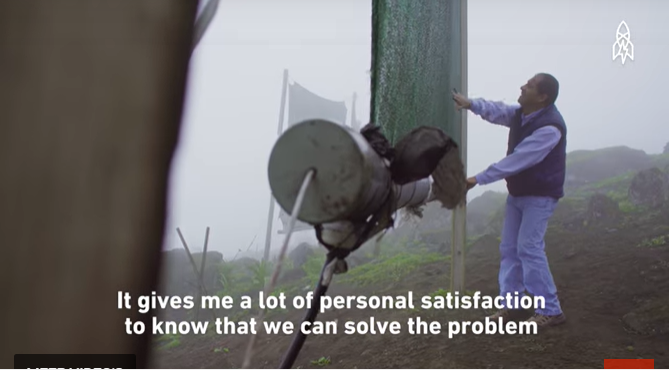Cloud milkers and fog catchers
Exhale on a cool mirror and you see condensation: water vapor that cools to droplets.
Air contains a certain amount of water vapor. Just like you can dissolve more sugar in warm water, warmer air can also contain more water.
If air cannot contain more water vapor, its saturation point is reached. Water vapor then starts to condense, so to turn into liquid. The temperature at which this happens is called the dew point. The water molecules stick together and form small droplets or dew. At freezing temperatures, water vapor changes directly into ice crystals: this is called sublimation. When dew first develops and freezes later, we call it ripe.
The amount of water vapor in the air is the humidity. The absolute humidity is the volume of water vapor at a certain temperature per m³ of air. The relative humidity represents the percentage of water vapor relative to the maximum saturation. A relative humidity that is comfortable for us is above 40% ("dry lips") to 70% ("damp"). Above 100%, condensation occurs in the form of dew, frost and fog, or indoors as condensation.
At a temperature of 15 degrees, one kilo of air can contain a maximum of 10.7 grams of water vapor.
Every year around 505,000 cubic kilometers of water evaporate.
The air contains about 0.001 percent of all the water on earth, good for 12,900 cubic kilometers, or 1.29 x 10 ^ 16 liters of water. About a third of all freshwater is in the air.
A lot of water evaporates above the sea. Above a cold land mass (e.g. desert before sunrise) that forms fog. Some plant and animal species use it to harvest water even in bone-dry deserts.
The grass Stipagrostis sabulicola can live off precipitated fog drops that roll down leaves and stems. Trees are also excellent fog catchers. In generous villages, dew drops have been collected from the leaves for generations.
The cover plates of the desert beetle Stenocara gracilipes are covered with a wax layer that makes them water-repellent (hydrophobic). On the shields are some kind of warts on which it is missing. They are hydrophilic and collect water. In the morning the beetle sets themself on the wind in such a way that the warts catch the maximum of water from the ocean mist. The growing drops automatically roll over the wax layer to the beetle's mouth.
Large surfaces that are cooler than air can serve as a fog catcher or water collector.
 In the Atacama Desert (Chile), the local population uses nets to catch fog water. A square meter of fog net harvest approximately one liter of water per day. The fine mesh of both water-attracting and water-repellent fibers collects tiny droplets in the nets until they swell and drip into a reservoir. The technique is also used in Peru, Ghana, South Africa and Morocco.
In the Atacama Desert (Chile), the local population uses nets to catch fog water. A square meter of fog net harvest approximately one liter of water per day. The fine mesh of both water-attracting and water-repellent fibers collects tiny droplets in the nets until they swell and drip into a reservoir. The technique is also used in Peru, Ghana, South Africa and Morocco.
Sponsh is a Dutch 'smart textile' solution that delivers 1.3 liters of water with 1 m² per day.
Warkawater is a bamboo tower that takes 100 liters of drinking water out of the air every day.
There are also (underground) containers with a funnel lid that condenses water from air, such as the Dew Bank Bottle Air Drop Irrigation and the Groasis Waterboxx. (This principle is also used in survival techniques.) The (wind-driven) WaterSeer uses the same idea, but turns out to be less effective than expected by the designers.
Fontus is a water bottle (for the bicycle) that uses a kind of toothbrush hair and a solar panel (or battery) to extract water up to 0.5 liters / hour from moist air.
(There are also more technical and rather industrial designs to extract water from air, such as Eole Water (wind turbine), EcoloBlue, UTEC billboard, Potable Water Generator, WaterGen.)
Even with little water you can do a lot in an economical way (in the garden).
I tried to catch fog yesterday. Mist.
